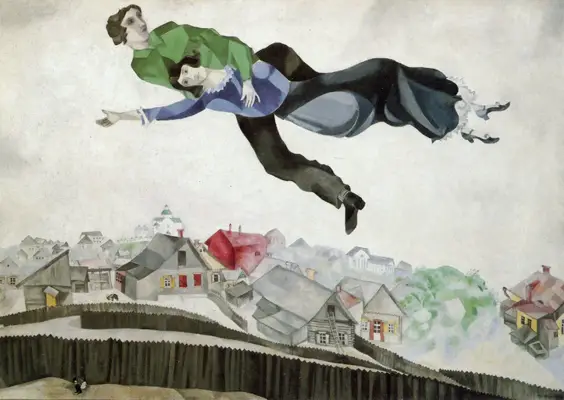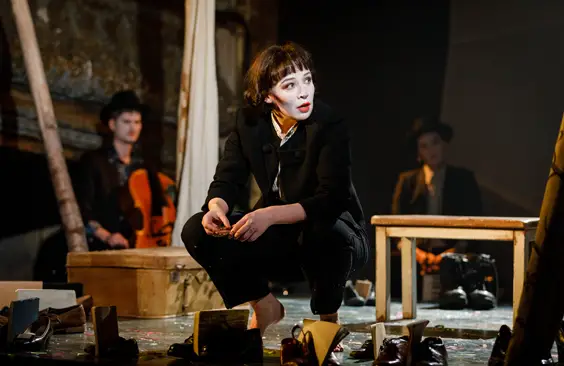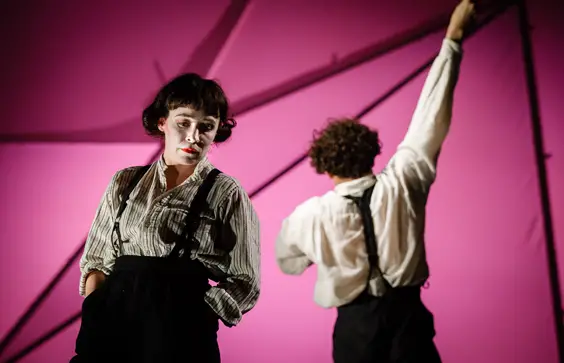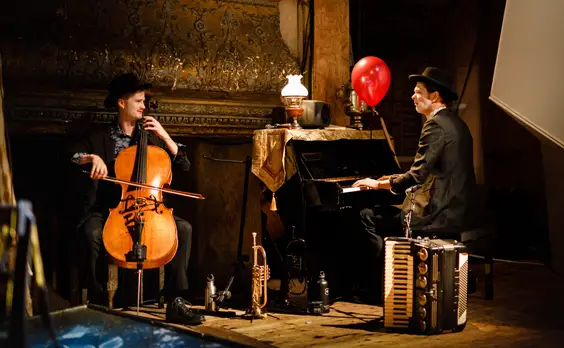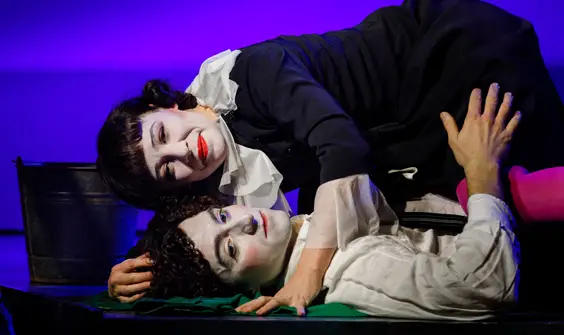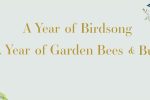The Flying Lovers of Vitebsk – Review – West Yorkshire Playhouse
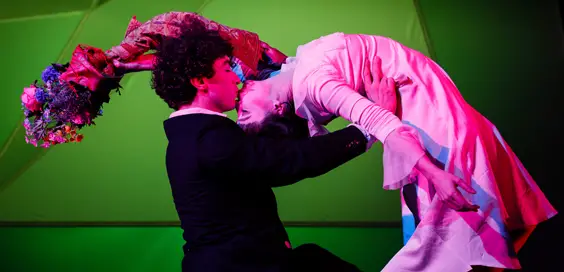
By Eve Luddington, March 2018
Some of the most exciting productions I’ve seen have been directed by Emma Rice for the multi-talented internationally touring theatre company, Kneehigh, of which she’s a former Co-Artistic Director. This, although a relatively small-scale production for Kneehigh, with two actors and two musicians, has many of the qualities that make Rice such a thrilling director and the company so richly innovative in combining all aspects of theatre to offer the audience a banquet of delights.
The Flying Lovers of Vitebsk was first written more than 25 years ago by Daniel Jamieson when he and Emma Rice were about to be married. It was inspired by a painting by Marc Chagall (1887-1985), ‘Over the Town’ (pictured below), which depicts the artist embracing his wife, Bella, as they fly over the Russian town in which they were born. As Rice notes in the programme, the play was ‘Made by two people very much in love about two people very much in love.’ Now separated, she and Jamieson collaborated on this production.
“Tensions between artistic commitment and daily need”
Born a Jew in pre-Revolutionary Russia, Chagall was the eldest of seven children whose father was a herring merchant and mother sold vegetables from home, his prospects low. At that time, Russian Jews were confined to particular areas and subject to state racism and brutality. Pogroms threatened their very existence. As a young man, Chagall denied his Jewishness in order to save his life.
The Flying Lovers of Vitebsk is a love story, framed as a collection of Chagall’s memories. The focus is his relationship with his wife, Bella, a highly educated woman whose family background was more affluent. Some of the most moving pieces of text are taken from her writings, unpublished during her life. Of her first meeting with Chagall, she says: ‘I felt hot with apprehension… as if something were scorching me. Light spread over the walls, and against them appeared the face of a boy… his eyes, they were as blue as if they’d fallen straight out of the sky.’
But Bella’s frustration with her husband’s unworldly devotion to his art permeates the piece, highlighting the tensions between artistic commitment and daily needs which, for this couple, sometimes included a struggle for survival. Early and mid 20th-century world events created havoc and tragedy for them.
“Delicious, vibrant scenes”
Although he had already met Bella by 1910, Chagall ‘escaped’ Russia that year to Paris where he immersed himself in modernist art, for which he would become feted internationally. He returned to Vitebsk in 1914 to marry his lover. They lived through the Revolution and World War I in Russia, their Jewishness a threat to their very existence, then spent 20 years as exiles from Russia, mainly in France and America.
In World War II their beloved Vitebsk was occupied by Nazis. Many of its buildings were destroyed and most of the Jewish population perished. Bella’s death in 1944 coincided with news of the extermination camps in Europe. In the play, Marc’s character explains some of his drive to paint the past: ‘When things are gone, you feel an agony of need to remember.’
The show spans the couple’s life together with a highly theatrical piece of story-telling rather than a plot-driven drama. It combines seamlessly a script full of poetic imagery with music; mime; song, and dance. The seemingly simple set and props carry references to Chagall’s modernist art, and somehow convey the solidity and the vulnerability of the couple’s relationship. A heavily raked slab of flooring with wooden supports and uprights like pit props becomes a wedding canopy in one of the most delicious, vibrant scenes but it is hung with ropes and a noose. The backdrop, a fragmented screen which occasionally silhouettes the performers, is awash with coloured light. This show is a feast for the eyes and ears.
“Witty slapstick with tragedy and melancholy”
Ian Ross, the composer and fellow musician, James Gow, are integral to the performance, on-stage throughout playing tunes which capture both the aching poignancy and chutzpah of Jewish folk music, and the tumultuous experiences of 20th century Jews. Their virtuoso performance is matched by their sensitivity as fleeting characters and as stage hands. Both they and the performers are white-faced and at times clownish, as befits the show’s juxtaposition of witty slapstick with tragedy and melancholy; humour with a Jewish flavour.
Marc and Bella Chagall are wonderfully realised in high energy performances by Marc Antolin as Marc and Daisy Maywood as Bella, their love expressed with enormous skill and beauty through harmonious song, movement and dance; their jangling tensions likewise echoed.
Marc Chagall is portrayed as an innocent, almost Chaplinesque figure, his art all-consuming, his thoughtlessness deeply hurtful. In one scene, he returns on a high from a successful four-day trip during which Bella, at home, has given birth. When she tries to show him their daughter and relate the pain of birthing, he retorts: ‘Do you think what I do happens painlessly?’
“Impeccable timing”
Antolin’s deft transitions between absent-minded clumsiness, insensitivity and utter grace, as well as his rapport with the audience are compelling. The empathy between him and Maywood are palpable; they work in perfect harmony with impeccable timing. Daisy Maywood looks dainty and delicate but she nuances exquisitely a potentially clichéd character – the intelligent, self-sacrificial wife whose own prodigious talent goes unrecognised. Her Bella is entirely believable. And is she feisty! It was Bella’s worldliness that saved their relationship and their lives, and Maywood’s portrayal is superb.
The piece is steeped in ‘incidental’ inventiveness. A red balloon, held by Bella, characterises a blushing friend; a painting of a rabbi is animated by hands poking through the canvas. Such touches enhance the entertainment and shine light on the Chagalls’ creativity.
The Flying Lovers of Vitebsk doesn’t attempt to analyse Chagall’s art or to delve deeply into the psychology of the couple. It does aim, according to Daniel Jamieson’s notes, to evoke the sense of exile and to resonate the trauma of the refugee experience for today’s audiences. For me, that doesn’t come across.
“Shook the artist to his core”
Shoes and suitcases are placed at the edges of the raked floor to suggest the pair’s 20 wandering years. Otherwise, the theme of exile is underdeveloped which leaves a large hole in the production, perhaps for me more than most: my mother was a Jewish refugee from Nazi Germany, an artist deeply impacted by her experiences, who admired Chagall and, like him, tried to come to terms with and communicate her sense of exile through visual art.
Missed too, I think, was Chagall’s association of his wife’s death with news of the extermination camps in Europe – which shook the artist to his core. These, and other scenes towards the end of the show seem sketched without much tone or colour. Sadly, my emotional engagement diminished and I became aware of sitting on the hard seats of the Courtyard Theatre for 90 minutes without an interval.
Better communicated was Chagall’s realisation after her death of Bella’s individuality: ‘It had never occurred to me that, though we saw the same things, she saw them with her own eyes.’ In recognition of her, Chagall went on to illustrate and publish her notebooks. That’s where I would have liked this love story to end. The last scene was distinctly underwhelming and, for a few minutes afterwards, I forgot how much I’d relished so much of the rest of the show.
images: Steve Tanner
